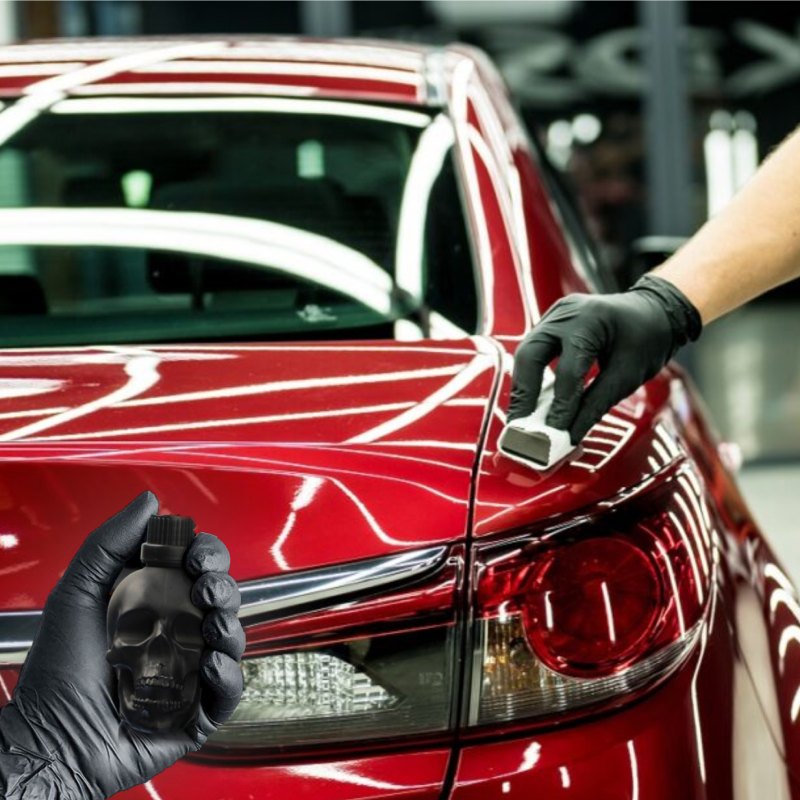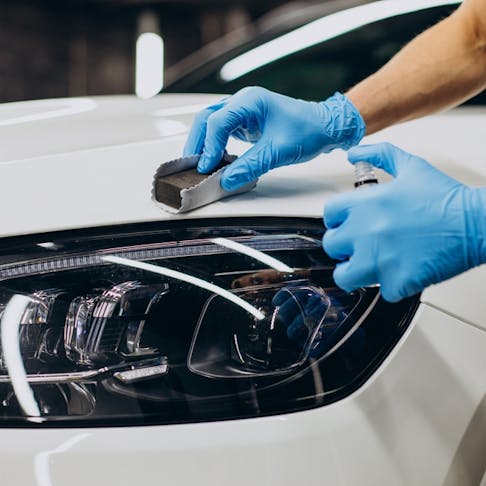Twelve key benefits why drivers choose Ceramic Coating Newark
Checking out the Science Behind Car Ceramic Coating and Its Protective Residences
The scientific research of car ceramic coating provides a fascinating study in advanced vehicle security. Made up largely of silicon dioxide and polymers, these coatings create a durable bond with lorry paint. This interaction boosts longevity versus environmental dangers while offering hydrophobic benefits. However, the ins and outs of just how these coverings job and their lasting benefits remain less understood. Unboxing these information exposes why ceramic coatings are becoming a preferred option for car treatment
What Is Ceramic Coating?
Ceramic coating is a fluid polymer that chemically bonds to the surface of a car's paint. This advanced protective layer enhances resilience and provides remarkable resistance to ecological elements. Unlike traditional wax or sealers, which give short-term protection, ceramic finishes develop a lasting guard that can endure rough conditions such as UV rays, acidic contaminants, and extreme weather condition. When applied appropriately, the coating develops a hydrophobic surface area, creating water to grain and slide off, which aids in maintaining the car's tidiness. Additionally, it uses boosted gloss and depth to the paint, making the vehicle appear more polished and vibrant. The application process commonly entails thorough surface prep work, including cleansing and sprucing up, to guarantee peak bonding. Consequently, ceramic layers are becoming increasingly preferred among car fanatics and those seeking to safeguard their investments, promising to maintain the vehicle's aesthetic appeal while minimizing the regularity of upkeep.
The Make-up of Ceramic Coatings
The complex formulation of ceramic coatings mostly includes silicon dioxide (SiO2), which is acquired from natural sources like quartz and sand. This crucial element gives the foundation for the coating's toughness and safety high qualities. Along with SiO2, ceramic layers typically consist of different polymers and ingredients that boost attachment, versatility, and resistance to environmental variables. These substances work synergistically to develop a durable obstacle against contaminants such as dirt, chemicals, and UV rays.Furthermore, some solutions incorporate titanium dioxide (TiO2) or various other nanomaterials, which can increase the coating's hydrophobic buildings, causing improved water repellency. The accurate structure can vary substantially amongst producers, impacting efficiency and long life. Eventually, the mix of these elements finishes in a protective layer that not just boosts the aesthetic charm of vehicles however additionally serves to lengthen their lifespan by shielding the surface area from prospective damages.
How Ceramic Coatings Work
Comprehending exactly how ceramic coverings function includes exploring their chemical composition, which adds to their protective top qualities. The application procedure is important for accomplishing perfect results, while durability and longevity elements figure out the coating's effectiveness over time. With each other, these elements highlight the benefits and performance of ceramic finishings for car security.
Chemical Composition Explained
While several car proprietors seek lasting security for their automobiles, the chemical composition of ceramic coatings plays an important function in their efficiency. These finishes mainly include silicon dioxide (SiO2), which is stemmed from natural minerals. This compound creates a solid bond with the lorry's paint, creating a resilient, protective layer. Furthermore, numerous ceramic finishes include titanium dioxide (TiO2), improving their hydrophobic buildings and resistance to UV rays. The visibility of polysiloxanes can further boost adaptability and toughness. Together, these elements add to the coating's ability to repel water, dirt, and impurities, while additionally offering a high-gloss finish. Understanding this chemical structure helps car owners appreciate the robust protection offered by ceramic coverings.
Application Refine Introduction
Using ceramic coatings involves a careful process that ensures excellent bonding and protection for the car's surface area. Complete cleaning and decontamination of the car's outside are executed to get rid of dust, gunk, and previous waxes. This step confirms that the surface is without impurities that might impede bond. Following this, the paint is often polished to enhance quality and get rid of any imperfections. As soon as prepared, the ceramic coating is applied in little sections using an applicator pad, permitting pop over to this web-site consistent coverage. The coating is then entrusted to cure, creating a solid chemical bond with the surface. Proper treating times and problems are crucial, as they validate the coating achieves its maximum effectiveness and protective high qualities.
Durability and Durability Factors
Ceramic layers are developed to supply resilient protection through their innovative chemical make-up, which produces a robust obstacle versus ecological pollutants. The toughness of these finishings is influenced by aspects such as the density of the application, the high quality of the item, and the problems under which the vehicle is exposed. Top notch ceramic coatings can last numerous years, standing up to scrapes, UV rays, and chemical discolorations. Correct maintenance, including normal cleaning and regular reapplication, can better enhance durability. Furthermore, ecological factors like climate and direct exposure to pollutants can affect the lifespan of the coating. Generally, when applied and preserved appropriately, ceramic coverings offer extraordinary resilience, making them a preferred option for car enthusiasts looking for to maintain their lorry's appearance.
Hydrophobic Properties and Water Repellency
Hydrophobic homes are a characteristic of top quality car ceramic finishings, considerably enhancing the lorry's surface area performance. These finishings produce a molecular bond with the car's paint, leading to a surface area that pushes back water efficiently. When water comes into contact with a ceramic-coated surface, it beads up and rolls off, decreasing the quantity of liquid that stays on the paint. This behavior not only adds to an aesthetically pleasing appearance but likewise minimizes the build-up of pollutants such as dirt, crud, and road salts.The boosted water repellency brings about easier cleansing and maintenance, as much less initiative is required to get rid of undesirable materials. Additionally, the hydrophobic nature of ceramic coatings aids in stopping water spots, which can mar the coating of uncoated surfaces. Generally, the unification of hydrophobic residential properties in ceramic coverings plays an important duty in preserving the automobile's excellent look while simplifying maintenance.
Protection Versus Scratches and UV Damage
Car ceramic finishings provide substantial security versus scrapes and UV damage. The scrape resistance device develops a long lasting layer that takes in influences, while the UV protecting benefits assist maintain the lorry's paint honesty in time. Together, these functions contribute to a longer-lasting and aesthetically attractive coating.
Scratch Resistance System
Making use of sophisticated technology, ceramic layers offer a durable guard against scrapes and UV damages, boosting the durability and look of car surface areas. The scrape resistance device of these finishes is credited to their one-of-a-kind molecular framework, which creates a long lasting bond with the vehicle's paint. This bond produces a hard, protective layer that can absorb influences and stand up to abrasions. Additionally, the smooth surface of the coating lowers rubbing, making it hard for impurities to stick and cause scratches. The chemical make-up of ceramic coatings commonly includes nanoparticles that reinforce the safety layer, further boosting its strength. Vehicles treated with ceramic finishes display markedly enhanced scrape resistance contrasted to conventional wax or sealants, making certain an immaculate surface over time.
UV Shielding Benefits
The protective top qualities of ceramic coatings extend beyond scratch resistance to consist of considerable UV protecting advantages. These finishes develop a durable barrier that shows damaging ultraviolet rays, protecting the car's paint and underlying products. Prolonged exposure to UV radiation can bring about fading, oxidation, and degeneration of the paint coating. By integrating ceramic coverings, lorry proprietors can successfully mitigate these dangers, maintaining the aesthetic appeal and honesty of their cars. Additionally, the UV blocking properties add to boosted long life, lowering the regularity of repainting and maintenance. Inevitably, the integration of ceramic layers provides a detailed solution for safeguarding lorries from the harmful results of sun exposure, making certain a see this continual, lively appearance in time.
The Longevity and Maintenance of Ceramic Coatings

Frequently Asked Concerns
Can Ceramic Coating Be Applied to Any Type Of Sort Of Vehicle?
Ceramic coating can be put on various sorts of automobiles, consisting of cars, trucks, and motorbikes. Surface area preparation and compatibility with certain products are vital for perfect bond and effectiveness of the coating.
Just How Much Does Ceramic Coating Generally Price?
Ceramic coating usually costs between $500 and $2,000, relying on elements such as lorry size, coating quality, and specialist application. The investment can give durable security and boost the car's look gradually.

Is Expert Application Necessary for Ideal Outcomes?
The need of expert application commonly relies on wanted outcomes. Specialists normally assure appropriate surface prep work and application strategies, resulting in suitable bonding and long life of the coating, which may be challenging for unskilled people to achieve.
Can Ceramic Coatings Be Removed or Repaired?
Ceramic finishes can be gotten rid of or fixed, though the process might require specific solvents or strategies - Ceramic Coating Newark. Proper elimination is necessary to avoid damages to the underlying surface, stressing the value of professional support for suitable outcomes
Just How Does Porcelain Coating Compare to Conventional Wax?
The contrast between ceramic coating and traditional wax discloses that ceramic finishings offer remarkable resilience, improved security versus environmental pollutants, and longer-lasting luster, while wax requires more constant application and provides much less overall resistance to damages.